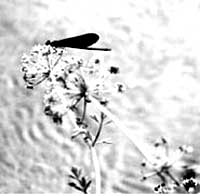Nature s midwives
 human activity is causing a decline in the populations of bees, birds, bats, butterflies, beetles, wasps, flies, moths and other creatures that function as pollinators, says a recently published study. Epidemics of a mite known as varrora in Europe and North America destroyed millions of honeybee colonies. Hundreds of commercial crops depend on these pollinators. In all, some 200 wild vertebrates who are pollinating agents face extinction around the world ( Conservation Biology , Vol 12 p 40).
human activity is causing a decline in the populations of bees, birds, bats, butterflies, beetles, wasps, flies, moths and other creatures that function as pollinators, says a recently published study. Epidemics of a mite known as varrora in Europe and North America destroyed millions of honeybee colonies. Hundreds of commercial crops depend on these pollinators. In all, some 200 wild vertebrates who are pollinating agents face extinction around the world ( Conservation Biology , Vol 12 p 40).
Pollination is an important factor in the evolutionary adaptation of plants and animals to the respective ecosystems that are changing constantly. The characteristics of plants that we see today have taken thousands and millions of years to materialise. However, human interference is taking only a few decades to hinder this evolutionary progress. The result: plant species deprived of pollination will soon become history.
The loss of a single pollinating species can lead to the collapse of an entire ecosystem. Gary Nabhan of the Arizona Desert Museum, usa , and the main author of the study, cites the example of some Pacific Islands where the loss of flying foxes (fruit-eating bats) could lead to the extinction of mammals dependent on the fruits from trees pollinated by the bats. Documented details of some species of invertebrates and vertebrates are also available.
At least 45 species of bats are of global conservation concern, including nine species considered to be extinct in the wild, according to Nabhan. Whereas bat pollinators are endangered in Australia, Africa, North America, South and Central America, and Asia, the hardest hit are species of microchiroptera (species of bats that are smaller in size) restricted to individual islands or archipelagos. For megachiroptera (fruit bats and flying foxes), the main threats in order of importance are hunting, deforestation, introduction of exotic predators, and unpredictable environmental disturbances, such as volcanoes. The most serious threat to microchiroptera are habitat destruction or disturbance of roosting caves and mines.
Declining bat populations threaten the survival of many tropical fruit trees, the wild banana for instance. Trees like neem and eucalyptus are also threatened by the dwindling populations of bats. The threatened status of certain primates in Madagascar, Rwanda, Uganda and Zaire also threaten the biodiversity of the region. The Madagascarian lemur (a mammal similar to the monkey) is the only primate with the agility and the strength in its fingers to open the buds of the travellers' tree ( Ravenela madagascariensis ). Nabhan's study indicates that there is a great need for more research and data on invertebrate pollinators.
Ecologists from the uk warn that honeybees in Europe are also declining in number because of varrora mites. A quarter of the 250 bee species native to the uk are now classified as "rare' or "threatened'. These bees pollinate fruit crops and other wild plants. The study points out that although most pollination biologists have focused on nectar specialists such as hummingbirds and honey creepers, birds like the finch and the vireo often play important roles as secondary pollinators of many flowering plants
The effect on biodiversity will be incredible due to declining numbers of pollinators. The World Conservation Union ( iucn ) predicts a global loss of 20,000 flowering plant species within the next few decades. This will undoubtedly cause the decline of the pollinators that need them for survival.
Pollinators that are specific to certain plant groups are at a higher risk than "general-list' pollinators, which pollinate more than one plant group. The loss of specialised pollinators will lead to the reduced genetic variability in plants, resulting in a possible reduction in their evolutionary adaptability to environmental change.
Populations of many native plants and their pollinators are suffering due to habitat fragmentation and degradation. The use of herbicides to keep deforested patches open can often aggravate a change in the density of the forest cover, resulting in destruction of native plant varieties.
According to a report published in 1977, use of pesticides and the resultant destruction of pollinators caused a multi-million dollar loss in the blueberry crop in New Brunswick, usa . Alfalfa seed crop losses have been attributed to pollinator loss through the ages. Failures of cashew crops in north Borneo have been linked to the absence of pollinators after moving a particular species of cashew from its native habitat in Brazil to the tropical areas outside the Americas. Pollinator losses can also affect the quality of the harvest, besides affecting the quantity.
